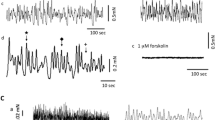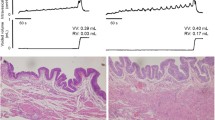Abstract.
In this study we have characterized the role of sensory fibers and of the sensory peptides, neurokinin A (NKA) and calcitonin gene-related peptide (CGRP), on the contractile responses evoked by single pulse electrical field stimulation (EFS) in the hamster urinary bladder.
EFS of the hamster isolated urinary bladder produced twitch contractions which were unaffected by atropine but abolished by tetrodotoxin. The P2 purinoreceptor antagonist PPADS (30 µM) inhibited twitches by 66±4% on its own and by 78±3% in the presence of atropine. The selective tachykinin NK2 receptor antagonist nepadutant produced a slight but consistent reduction of twitch amplitude (–21±3%) at 1 µM. Addition of nepadutant to atropine and PPADS did not further increase their inhibitory effect.
The application of hCGRP (10–300 nM) produced a concentration-dependent inhibition of twitches (E max –38±3%, EC50=12 nM) and a small reduction of tone (0.5±0.09 mN).
Similar effects were obtained with capsaicin (0.1–10 µM) which inhibited EFS-evoked contractions with an EC50 of 100.0 nM and a maximal effect of 34±4% inhibition at 1 µM.
Under submaximal parameters of stimulation NKA (10 nM) increased the amplitude of twitches by 45±6% and produced a concentration-dependent tonic contraction (EC50=55.9 nM). The CGRP1 receptor subtype antagonist, hCGRP(8–37), increased by 29±8% the EFS-evoked contractions and significantly reduced the response to 0.1 µM CGRP.
Capsaicin (10 µM) increased both CGRP-LI and NKA-LI release from superfused slices of hamster urinary bladder by about sixfold and by about 70%, over baseline, respectively. A second application of capsaicin was ineffective, indicating a complete desensitization of sensory nerve efferent function.
In the hamster urinary bladder the sensory neuropeptides NKA and CGRP are co-released by sensory fibers after stimulation either by EFS or capsaicin. However, the role of CGRP appears functionally predominant.
Similar content being viewed by others
Author information
Authors and Affiliations
Additional information
Electronic Publication
Rights and permissions
About this article
Cite this article
Giuliani, S., Santicioli, P., Lippi, A. et al. The role of sensory neuropeptides in motor innervation of the hamster isolated urinary bladder. Naunyn-Schmied Arch Pharmacol 364, 242–248 (2001). https://doi.org/10.1007/s002100100447
Received:
Accepted:
Issue Date:
DOI: https://doi.org/10.1007/s002100100447




